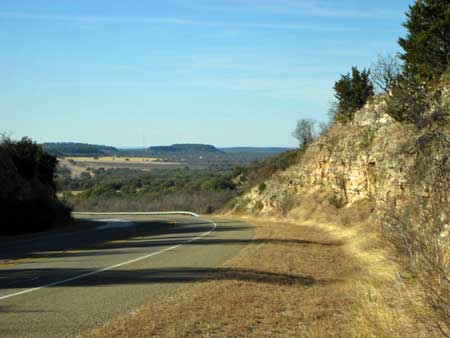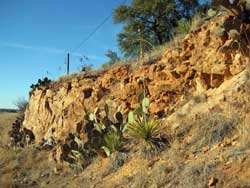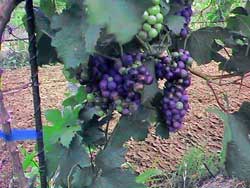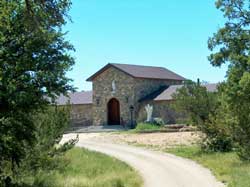
From the Mediterranean Shores to Mason County Texas:
Act II – Seeing, Tasting and Praying for Terroir
About 4 pm in the afternoon, my wife and I departed our Hill Country cottage near Fredericksburg, Texas and started the hour and a half drive to Mason for the much anticipated Act II dinner and tasting at Sandstone Cellars. As I learned in the process, this drive was likely the best way to see the “big picture” view of what Don Pullum had discussed in his description of Mason County terroir (See https://vintagetexas.com/?p=612).
 We headed west on Route 290 from Fredericksburg and, within minutes, the limestone road cuts at the eroded edge of the Edwards Plateau started to fall away. The countryside morphed into outcroppings of even more ancient, burnt-orange “Hickory” sandstone with a magnificent view of the Llano Basin open before me. The meeting of water on rock in Mason County is there, available to the beholder; a visible slice of geological time over 500 million years that produced a very particular ‘terres de la vigne’.
We headed west on Route 290 from Fredericksburg and, within minutes, the limestone road cuts at the eroded edge of the Edwards Plateau started to fall away. The countryside morphed into outcroppings of even more ancient, burnt-orange “Hickory” sandstone with a magnificent view of the Llano Basin open before me. The meeting of water on rock in Mason County is there, available to the beholder; a visible slice of geological time over 500 million years that produced a very particular ‘terres de la vigne’.
The basin and its Hickory Sands were crafted by local uplift and subsequent erosion first removing the limestone overburden and, in more recent times, eating still further down into the older, now-exposed sandstone. This process produced a mineral-rich sandy soil and left isolated limestone-topped mesas to dot the landscape, a scene similar to one I experienced in Bandol in southern France.
I stopped and got out of the car to take in the roadside view and to connect with the local terroir. After I returning, it became evident just how intimate my connection had been. I was destined to extract prickly pear cactus stickers from my ankle for the remainder of the evening and, with the help of my wife, the following day, as well. So much for connecting with the land!
From Mulligatawny to Menudo
When we arrived at the winery, it was obvious that winemaker Don Pullum and winery proprietors Manny Silerio and Scott Haupert were in good spirits from their afternoon of culinary endeavors. The house adjoining the winery was a snapshot out of Mason County history complete with a personal memoir of the house’s former owner, Lucia Holmes, from the late-1800s with some of her recollections of the local goings from her day and time. But, for today it would serve as a very exclusive restaurant for us to share.
 Mason County has a colorful history being the alleged setting for the so-called ‘Hoodoo War’ that was complete with cattle rustling, shootings, and hangings, and with outlaws, Confederates, Unionists and Texas Rangers all running around trying to kill one another for various reasons. It has been said that eventually there was enough blood on the ground in Mason that the whole episode came to an end when there were not enough enemies left to sustain the fighting any longer.
Mason County has a colorful history being the alleged setting for the so-called ‘Hoodoo War’ that was complete with cattle rustling, shootings, and hangings, and with outlaws, Confederates, Unionists and Texas Rangers all running around trying to kill one another for various reasons. It has been said that eventually there was enough blood on the ground in Mason that the whole episode came to an end when there were not enough enemies left to sustain the fighting any longer.
With this tale to complete the historical setting, we sat down for the first dinner course featuring two of Don’s creations: A spicy Mulligatawny Soup and Sandstone Cellars’ first wine, a 2004 Syrah. As Don related, “This was the only vintage were we could actually use a single varietal designation on our wine being that it contains eighty percent Syrah. Since then, we have been focusing on blending to produce wines of added complexity using small batches from local growers. The process is quite similar to that of an artist mixing colors from his palette to apply on the canvas.” I guess the difference in Don’s case, is that the canvas is in a bottle.
From my experience, most people do not think of wine pairings with soup courses, and particularly they do not consider a red wine as fair game in this process. But, in this case, the soup and the wine worked wonders together. The spicy richness of the soup paired one-for-one with the wine’s natural fruit richness and the hint of pepper spice on the finish. Near the end of this course, with glasses raised, Don declared, “Now this is Mulligatawny!” The enjoyment of this dish caused Manny and others at the table to speculate that the Syrah might also compliment with other spicy soups, one with a more local familiarity – Menudo.
Everything but the Kitchen Sink
Next out of the kitchen was broiled quail with a selection of raspberry and cilantro sauces served with Sandstone Cellars II, a red blend of eight different Mediterranean grapes all from Mason County. I immediate recognized the style of wine and indicated to Don that it reminded me of a memorable wine that he had previously made from his vineyard called L’Evier (translated from French it means – The Kitchen Sink). He chose this name for that wine because it was composed of so many different Mediterranean red grape varieties that he was literally throwing in “the kitchen sink”. I took a bottle of the L’Evier on a trip to the French Rhone Valley and shared it with a rather noted winemaker – Yves Gras at Domaine Santa Duc in Gigondas. For Gras reaction and Don’s even greater surprise see my previous blog post at: https://vintagetexas.com/?p=3.
Upon hearing my comparison of the Sandstone Cellars II with his L’Evier, Don responded with a big smile and said, “It is interesting that you noticed that connection. My goal with the Sandstone Cellars II was to recapture the spirit of my L’Evier. It is a blend of seven red grape varieties and one white, all of Mediterranean heritage.”
The 2005 Sandstone Cellars II was concentrated and very floral in character with sweet fruit qualities despite its completely dry vinification. Don mentioned that “The dominant sensory elements of this wine appear to be presently red cherry coming from the Sangiovese or the Primitivo in the blend. Interestingly, this wine initially had more of a Rhone style and now with a little bottle aging an Italian character is starting to show.” This course finished with Manny and Scott in a tug-of-war over the quails microscopic wish bone that appeared to me to be only relevant to wishes of very small expectations.
Hill Country Meets Low Country
The main course for the evening was a three hour red-wine braised lamb shank, a hearty fusion preparation including ginger, banana, and soy sauce. This was accompanied by collard greens with smoky bacon for a Hill Country meets Low Country amalgamation augmented with global flavors – or as we called it; our ‘world-beat version of the renown Luby’s Restaurant Lu Ann Platter’.
Don highlighted the appropriateness in the use of the word ‘fusion’ to describe both the food preparation and the Sandstone Cellars approach to winemaking. “In our wines, we are creating the wine equivalent to what many high profile chefs are now doing – A fusion of the flavor elements of different cultures and cuisines. The wines of Sandstone Cellars are a fusion of three, five or more grape varietals that are grown here, but that have a lineage going back to different countries around the Mediterranean Sea. These blends bring out intense qualities that go well with the modern fusion cuisines popular in both Texas and around the country. Here we find spicy and savory on the same plate, examples being Southwestern and Pan Asian cuisines. The savory and spicy qualities of our wines work exceptional well in this type of setting.”
The rich lamb preparation provided an excellent back drop for the grand performance of the evening which included three additional Sandstone Cellars red blends (III, V and a VI barrel sample) and the 2006 Domaine Sorin and 1998 Domaine La Suffrene Bandol obtained from Gabriel Mata at a Houston tasting last December described in a previous blog (See: https://vintagetexas.com/?p=612).
Wines Related by Bloodlines
In the 2006 Sandstone Cellars III blend (in excess of 50 percent Mourvedre), it was evident that this Mason County wine and the 2006 Domaine Sorin Bandol were related by their Mourvedre ‘bloodlines’. Both had inky-luscious, pubescent fruit-driven qualities, being just three years from their vintage date. The firm yet pleasant tannic structure obtained from the Mourvedre was also evident in both wines but to differing degrees.
The Domaine Sorin was just a tad darker and more tightly wound than the Sandstone Cellars III with the Sorin having notes of lead pencil and mineral (typically old world qualities) whereas the Sandstone Cellars III focusing more on its dark fruit superimposed with chocolate and toasted oak (new world qualities). These differences were likely due to a cooler climate in Bandol and the adolescent only ‘sixth leaf’ vines in Mason County. The good news was that both of these young wines were just begging to be saved for a decade of bottle aging; but alas, we offered them no reprieve. They succumbed that evening to the more immediate desires of our palates.
Making Wine One Grape at a Time
 During a short interlude, Don explained the harvesting techniques used for their wines and I learned how ‘picky’ he is about picking the grapes for his wines. He indicated that the grapes used in the Sandstone Cellars wines were all handpicked sometimes berry-by-berry rather than as whole clusters, usually at a rate of about 200 pounds a day. This method was used to harvest only the ripest berries which were then cold stored and crushed in 1000 pound increments. This method is similar to the technique of hand harvesting used in Germany referred to as Trokenbeerenauslese (or simply TBA) used to make some of the finest wines that originate from that country.
During a short interlude, Don explained the harvesting techniques used for their wines and I learned how ‘picky’ he is about picking the grapes for his wines. He indicated that the grapes used in the Sandstone Cellars wines were all handpicked sometimes berry-by-berry rather than as whole clusters, usually at a rate of about 200 pounds a day. This method was used to harvest only the ripest berries which were then cold stored and crushed in 1000 pound increments. This method is similar to the technique of hand harvesting used in Germany referred to as Trokenbeerenauslese (or simply TBA) used to make some of the finest wines that originate from that country.
Don said, “I am usually looking for more than just a particular sugar level in the grapes as an indication of when to harvest. I want structural maturity in the grapes that requires evaluation of the grape stems and the ripeness of the grape seeds. I will actually chew and taste seeds looking for a roasted flavor before we pick.” I mentioned to Don that the use of hand harvesting for his Mason County wines was another similarity with the wines of Bandol AOC. To use the Bandol AOC designation, the grapes from that region have to be both more than fifty percent Mourvedre and be hand harvested.
The 2007 Sandstone Cellars V was dominated by over 50 percent Syrah and was supported with lesser amounts of Primitivo, Mourvedre and Grenache. This wine was floral and aromatic, in a similar ilk as was the 2005 Syrah yielding a powerful sweet scent and matching flavor of red cherry with a smoky note on the nose.
We finished the tasting of the Sandstone Cellar wines with a barrel sampling of their 2008 VI blend that was only in barrel since September. It was dominated by Touriga Nacional (a dark-red Portuguese grape varietal) supported by contributions of Barbara, Primitivo and Zinfandel that yielded a fruity red current flavors and black pepper on the finish. Additional oak aging of this wine should infuse toasted oak qualities and also soften and integrate the fruit and spiciness of this new wine.
The 1998 Domaine La Suffrene Bandol was the true grand dame of the evening and showed elements that make Mourvedre-based wines so attractive to lovers of bottle-aged wines and that also make them particularly good values in the global wine marketplace. This wine still had power contained in its dark purple color and rich fruit flavors that had retained their strength over the decade since its vintage. The unusual aspect of this wine was that the power was combined with a graceful elegance of other soft mature flavors and fragrances only available in certain age-worthy wines. Collectively, we tried to come up with an accurate and concise description for this wine and eventually settled on the simple phrase, “Gone to elegance”.
Praying for Terroir
Before departing our fine festive feast, I asked Don how he settled on the Hickory Sands of Mason County for his vineyard. In response, Don told me the following story:
“Brother Fabian, a Carmelite hermit who founded the Mount Carmel Hermitage in Christoval, Texas, called it a spiritual journey. In December, 1997, I stumbled upon the hermitage while searching for a vineyard property in Texas. The eleven month journey took me as far north as the Red River, south to the Medina River, east to the Guadalupe River, and west to Christoval.”
 Don continued, “I learned that the hermitage had been a spiritual journey for Brother Fabian, as well. He had been in Rome grooming for a position within the Vatican, but discovered that prayer, silence, solitude, contemplation, penance and labor were more important to his devotion than climbing the religious hierarchy. Learning this, he staked a tent on rugged land in Schleicher County Texas, more suitable to scorpions than men, and began to pray. A small chapel was eventually built and other Carmelite monks joined him in this retreat.
Don continued, “I learned that the hermitage had been a spiritual journey for Brother Fabian, as well. He had been in Rome grooming for a position within the Vatican, but discovered that prayer, silence, solitude, contemplation, penance and labor were more important to his devotion than climbing the religious hierarchy. Learning this, he staked a tent on rugged land in Schleicher County Texas, more suitable to scorpions than men, and began to pray. A small chapel was eventually built and other Carmelite monks joined him in this retreat.
With the full attention of his dinner guests he closed by saying, “I sat in Brother Fabian’s cold chapel on that December morning, monks chanting in hypnotic Gregorian monotone, and listened to Father Fabian’s story. It was a story that offered me solace. I had only a vague understanding of why I was relinquishing the challenge and rewards available in American corporate life for a more bucolic life in the vineyard. Brother Fabian said that he’d have the brothers pray for me. Well, two months later, I was in Mason County plotting the vineyard layout kicking about in the Hickory Sands.”
————————————————————
For more information on Sandstone Cellars and their wines, see below:
Physical Address: 211 San Antonio Street, Mason, TX 76856
Mailing Address: P.O. Box 1246, Mason, TX 76856
Phone: (325) 347-9463
E-mail: wine@sandstonecellarswinery.com
Web site: www.sandstonecellarswinery.com
Scott Haupert and Manny Silerio, Owners
Don Pullum, Winemaker
Tastings, Restaurant, Art Gallery
Owners Scott Haupert and Manny Silerio were drawn to Mason, Texas in 1994. With family recipes from Manny’s mother, Santos, the two opened the highly regarded restaurant, Santos Taqueria, on Mason’s quaint town square in 1998. It was the same year Don Pullum planted the first vineyard, Akashic Vineyard, in Mason. Mason has attracted artisans, writers, sculptors, musicians and painters, including Bill Worrell, who’s painting “Kindred Spirits” graces the Sandstone Cellars label and whose bronzes, paintings and jewelry are displayed in the winery’s art gallery. Mason’s first winery opened next to the restaurant in 2004. The award-winning wines have highly aromatic bouquets, core varietal flavors and exquisite mouth feel. Experience the creativity, the food and wine, with an overnight stay at Scott and Manny’s adjoining Lucia Homes Guesthouse.
Visitors Welcome:
Thu-Sat 11am-6pm; Sun 11am-2pm; closed Mon-Wed

Be the first to comment